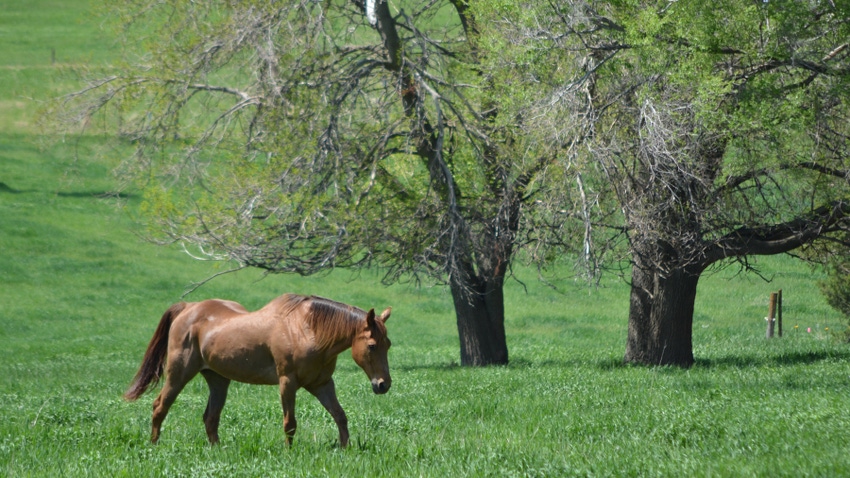
Ranchers pay plenty of attention to pasture management to get the most benefit from their grazing land forage resources for their cattle. It’s the same with horses.
A rule of thumb for stocking density on pasture for equine is 2 acres of healthy, well-managed and fertile pasture per 1,000-pound horse. According to Krishona Martinson, University of Minnesota Extension equine specialist, this stocking rate should provide most of a horse’s nutrition during the typical spring and summer growing season.
Pasture management is needed
It doesn’t mean, however, that pastures don’t need management when the horses are grazing. Overstocking horse pastures and overgrazing lead to less healthy, weedy and less productive pastures that will not support the usual stocking rate.
It may seem like common sense, but there are basic management tips to keep the pastures healthy through the growing season and, consequently, provide optimal grazing forages for horses.
Rotational grazing through a series of paddocks prevents overgrazing, Martinson says. “Horses don’t graze uniformly, and they prefer less mature grass,” she says. After grazing a particular paddock, mowing or shredding areas where grass is taller can help the pasture recover more uniformly during the rest period in preparation for the next grazing period.
Horses should be moved to the next paddock when the grass is grazed down to about 3 to 4 inches and can return to the paddock when the grass has grown back to 6 to 8 inches in height. If conditions are right, horses may be able to graze the same paddocks two or three times during the season.
Don’t overgraze
“Cool-season grass, for instance, can recover very quickly when conditions are wet and cool,” Martinson says. “Recovery is slower when it is hot and dry, and grass growth can stop, and forages become dormant when there are extended periods of drought.”
Instead of overgrazing paddocks without rest, horse owners can feed horses in a dry lot situation, just as they might do with cattle during drought, to provide alternative forages and baled hay without ruining pastures. “Start and stop grazing based on plant height, not by the calendar,” Martinson says.
The best way to prevent excessive weed growth in horse pastures is through proper grazing management, she says. “Avoid overgrazing, and keep soil fertility up so grasses can compete with weeds,” Martinson says. “If you use herbicides to control weeds, be sure to follow directions and grazing restrictions on the label.”
She also suggests dragging horse pastures two to three times each season to better distribute piles of manure, allowing the manure and nutrients to disperse into the soil through rainfall. If soil tests show a need for additional nutrients to maintain grass production, Martinson advises applying the first half of the fertilizer in the spring, with the balance applied in June. “It is best to apply fertilizer before light rainfall,” she says. “Then, hold off on grazing until the fertilizer pellets have dissolved.”
Prevent laminitis
Healthy horses can graze on normal pasture conditions without restrictions. Nonstructural carbohydrates, the starches and sugars found in plants, are a main energy source for grazing horses, Martinson says. But overweight horses and those prone to laminitis, or founder, may need extra management on pastures, she says.
Cool-season grasses like bluegrass or fescue can accumulate nonstructural carbohydrates. These are at higher levels in the plants in late afternoon on sunny days and at lower levels overnight, on cloudy days or in more mature grass.
“Drought and overgrazing increases levels of nonstructural carbohydrates in the grass,” Martinson says. “For horses that are more prone to laminitis, use caution when grazing in early spring or late fall, or grazing short or overgrazed and drought pastures. Graze those animals overnight. Maintain a healthy body condition score to lessen the risk of laminitis.”
Learn more at extension.umn.edu/horse-pastures-and-facilities/managing-established-horse-pastures.
About the Author(s)
You May Also Like






